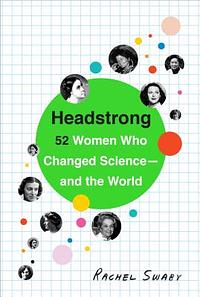Take a photo of a barcode or cover
informative
inspiring
fast-paced
The book was overdue so I finished with the audiobook but I definitely preferred reading since it helped me pay attention. Great bite-sized stories. My one complaint is I wanted to learn more about each science field but that's just because I love science. Well written for a wide audience.
I'm ashamed at the number of names I recognized without ever knowing they were women. Same for the discoveries.
informative
lighthearted
reflective
medium-paced
very interesting insight into the lives and creations of women
informative
inspiring
reflective
slow-paced
This was a great intro book to 52 remarkable women. Unfortunately, the inclusion of such a large number of women relegated most of their lifetime achievements to only a few pages. I think this would be a great book for a science classroom to introduce young students to these women, but to sit down and read all at once makes for a very disjointed experience.
adventurous
emotional
hopeful
informative
inspiring
reflective
medium-paced
Good brief history of 52 amazing women who opened doors for those that followed...both women and men in their fields.
challenging
hopeful
inspiring
fast-paced
Original review here: http://www.shainareads.com/2015/05/women-in-science-are-awesome-and.html
Disclaimer: I received Headstrong: 52 Women Who Changed Science—and the World from NetGalley in exchange for an honest review... and then reviewed it almost two months late. Oops. Regardless, thanks to Crown Publishing/Broadway Books for offering me the chance to read it!
The other day I was strolling through a local indie bookshop and noticed that Headstrong by Rachel Swaby had finally hit the shelves. I swelled with pride; this was the very first advance review copy that I'd ever been approved for on NetGalley, and here it was in all its published glory! That little bubble burst as soon as I remembered that I was only halfway through the ARC, despite the fact that the book was released back in early April. Well, better later than never, right?
Swaby's debut comprises 52 profiles of women and their accomplishments in the hard and medical sciences. Her impetus for writing Headstrong came from the New York Times's cringe-worthy missteps in its obituary of Yvonne Brill. Brill developed technology that allows communications satellites to stay in geosynchronous orbit; even non-rocket scientists like me can understand why that might be important. However, the news outlet thought it fit to lead their obituary with Brill's prowess in the kitchen, as a mother, and as a "follower" of her husband rather than, you know, her immeasurable contributions to her field. (A related note: The Times later changed the first paragraph of the obit with no mention of the edits.)
An accomplished journalist herself, Swaby laments that this kind of error is all too common when discussing women's scientific accomplishments and entirely absent from media praise of men:
Swaby strikes back against this injustice by painting vibrant, detailed portraits of the women behind a wide swath of scientific breakthroughs, including the inventor of the aquarium (Jeanne Villepreux-Power), the first pioneers in water sanitation testing (Ellen Swallow Richards), food and occupational safety (Alice Hamilton), and in vitro fertilization (Anne McLaren), and the discoverer of the earth's inner core (Inge Lehmann). We also learn about Rosalind Franklin, whom Watson and Crick scooped in the announcement of DNA's double-helix structure (Watson went on to insult Franklin's taste in fashion, classy guy that he is), and Emmy Noether, a brilliant mathematician whom Einstein spoke of as the reason he became competent in certain aspects of calculus. The list goes on and on.
Of all the magnificent women Swaby spotlights, her profile of Hedy Lamarr stood out to me in particular. Born in Vienna, Lamarr went on to become both a famed Hollywood actress and a significant contributor to methods that allowed for better guidance of torpedoes and the invention of Wi-Fi, GPS and other technology. Sadly, the only place I'd ever heard of Lamarr before this book was in Little Shop of Horrors, in reference to how hot a date she would be. Lamarr's story isn't unique in this regard; nearly all of these women's careers were rife with sexism. It's maddening (if unsurprising) how reluctant universities once were to allow women among their student and faculty ranks.
Some other reviewers have complained that Swaby seemed to favor quantity over quality in her profiles, but I would have to disagree. I would have been glad to have a few more pages about certain women, but I'm happy that she featured a large number of accomplished scientists and gave them the due they've long deserved.
I would recommend this book for anyone with even a passing interest in science and a desire to learn more about some of the countless women who helped shape the much more convenient, safe and technologically-sophisticated world we live in today.
Disclaimer: I received Headstrong: 52 Women Who Changed Science—and the World from NetGalley in exchange for an honest review... and then reviewed it almost two months late. Oops. Regardless, thanks to Crown Publishing/Broadway Books for offering me the chance to read it!
The other day I was strolling through a local indie bookshop and noticed that Headstrong by Rachel Swaby had finally hit the shelves. I swelled with pride; this was the very first advance review copy that I'd ever been approved for on NetGalley, and here it was in all its published glory! That little bubble burst as soon as I remembered that I was only halfway through the ARC, despite the fact that the book was released back in early April. Well, better later than never, right?
Swaby's debut comprises 52 profiles of women and their accomplishments in the hard and medical sciences. Her impetus for writing Headstrong came from the New York Times's cringe-worthy missteps in its obituary of Yvonne Brill. Brill developed technology that allows communications satellites to stay in geosynchronous orbit; even non-rocket scientists like me can understand why that might be important. However, the news outlet thought it fit to lead their obituary with Brill's prowess in the kitchen, as a mother, and as a "follower" of her husband rather than, you know, her immeasurable contributions to her field. (A related note: The Times later changed the first paragraph of the obit with no mention of the edits.)
An accomplished journalist herself, Swaby laments that this kind of error is all too common when discussing women's scientific accomplishments and entirely absent from media praise of men:
"We simple don't speak of men in science this way. Their marital status isn't considered necessary context in a biochemical breakthrough. Employment as an important aerospace engineer is not the big surprise hiding behind a warm plate of noodles." - Loc. 78, Headstrong
Swaby strikes back against this injustice by painting vibrant, detailed portraits of the women behind a wide swath of scientific breakthroughs, including the inventor of the aquarium (Jeanne Villepreux-Power), the first pioneers in water sanitation testing (Ellen Swallow Richards), food and occupational safety (Alice Hamilton), and in vitro fertilization (Anne McLaren), and the discoverer of the earth's inner core (Inge Lehmann). We also learn about Rosalind Franklin, whom Watson and Crick scooped in the announcement of DNA's double-helix structure (Watson went on to insult Franklin's taste in fashion, classy guy that he is), and Emmy Noether, a brilliant mathematician whom Einstein spoke of as the reason he became competent in certain aspects of calculus. The list goes on and on.
Of all the magnificent women Swaby spotlights, her profile of Hedy Lamarr stood out to me in particular. Born in Vienna, Lamarr went on to become both a famed Hollywood actress and a significant contributor to methods that allowed for better guidance of torpedoes and the invention of Wi-Fi, GPS and other technology. Sadly, the only place I'd ever heard of Lamarr before this book was in Little Shop of Horrors, in reference to how hot a date she would be. Lamarr's story isn't unique in this regard; nearly all of these women's careers were rife with sexism. It's maddening (if unsurprising) how reluctant universities once were to allow women among their student and faculty ranks.
Some other reviewers have complained that Swaby seemed to favor quantity over quality in her profiles, but I would have to disagree. I would have been glad to have a few more pages about certain women, but I'm happy that she featured a large number of accomplished scientists and gave them the due they've long deserved.
I would recommend this book for anyone with even a passing interest in science and a desire to learn more about some of the countless women who helped shape the much more convenient, safe and technologically-sophisticated world we live in today.





